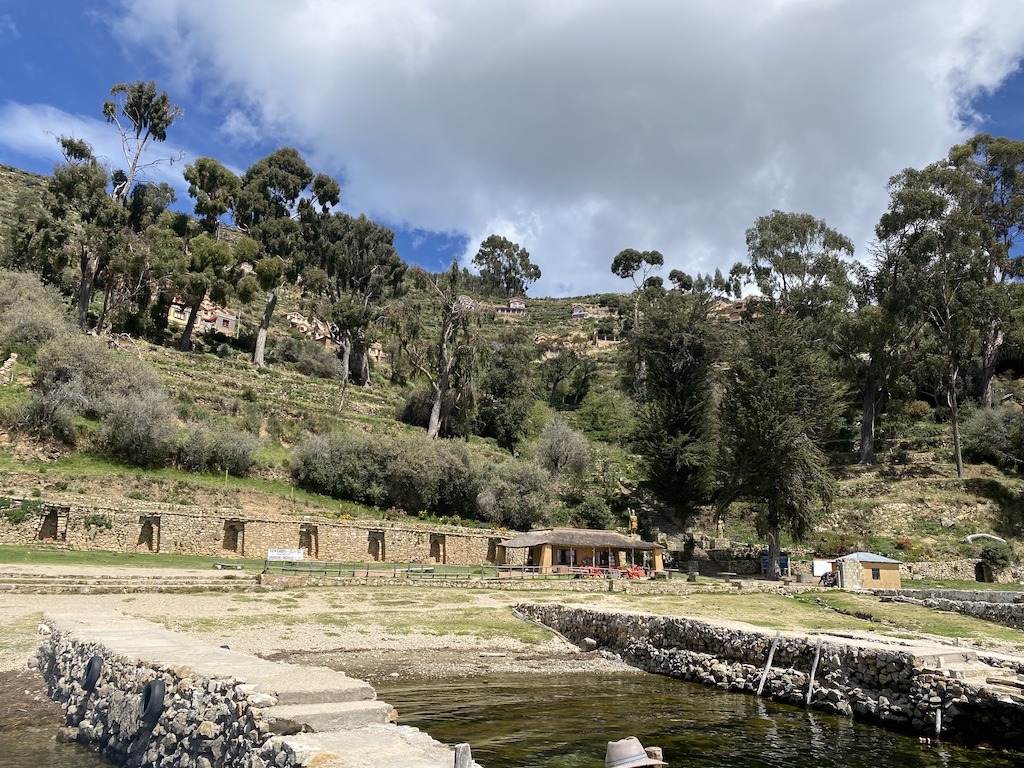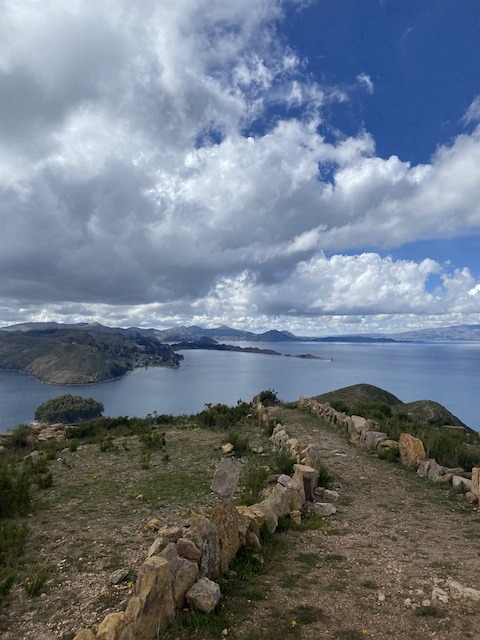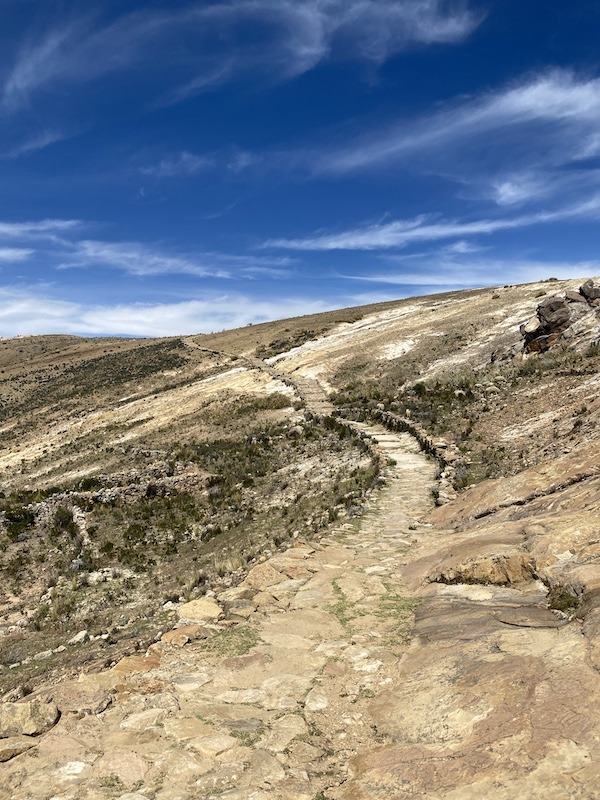How to visit Isla del Sol, Bolivia

For the ultimate sense of serenity, head to Isla del Sol. This island in Bolivia has got to be one of the most peaceful places I’ve ever visited.
I travelled to Isla del Sol in March 2023 and wish I had more time there. It was definitely one of my top highlights of Bolivia! Therefore, I’ve written this guide to visiting the island, so you have more of an idea of what to expect. It contains general information on what I thought to Isla del Sol, as well as practical details such as how to get there.
Ratings
Accessibility: 2/5 • Safety: 4/5 • Enjoyment: 5/5 • Value: 4/5 • Overall: 3.75/5
About Isla del Sol
Isla del Sol is an island located on the Bolivian side of Lake Titicaca.
You’ve probably heard of Lake Titicaca. As one of the highest altitude large lakes in the world and the largest freshwater lake in South America, it is internationally famous. The lake is shared by Peru, to the west, and Bolivia, to the east.
The size of Lake Titicaca is incredible. When I visited, it gave me the impression of the sea. Standing at the shoreline, you can barely see the other side of the lake, which just hovers on the horizon. It has waves like the ocean, and beaches like one too.
Lake Titicaca represents the way of life for a range of communities, which live on its shores or on one of its forty-one islands. The most famous is probably the Uros floating islands, close to Puno on the Peruvian side.
When visiting Lake Titicaca, Lou and I decided to visit Isla del Sol. Due to unrest in Peru during early 2023, we couldn’t cross the border to see Puno or the Uros islands, but we were perfectly content to visit just the Bolivian side!

A hilly island
Isla del Sol is pretty small, being 11 km long and 4 km wide at its maximum point. However, it still manages to be one of the biggest islands on the lake.
It’s also very high. Lake Titicaca is already located at an altitude of 3800 m, which the average person will feel. Isla del Sol is even higher than this, with its peaks reaching over 4000 km.
Walking around, the altitude will suddenly become very noticeable. The island is crazy hilly and any movement around it will undoubtedly result in having to go up a set of stairs or two!
Safe to say, if you plan to visit Isla del sail, by the end of your visit you’ll have done a lot of exercise. I was so knackered by the end of my trip.
Ancient ruins
Isla del Sol was incredibly important to the former Inca civilisation, whose empire extended across Peru and the surrounding areas during the 15th and 16th centuries. According to Inca legend, this island was the birthplace of the Sun; hence its name, which translates to “island of the sun”. Temples were built so that the Incan people could worship the sun god.
As such, you’ll find the occasional ruin scattered around the island. These are often subtle and blend into the landscape; I didn’t realise I had missed several on my walk through Isla del Sol, until I checked a map!
The most impressive set of ruins is of the former settlement of Chincana, in the northernmost tip of the island. Here, you’ll find the ruins of the ‘Palacio del Inca’, which date back to around the fifteenth century. You can walk through the structure, take a look at the altar, and admire the centuries-old handiwork.

Island community
There are several communities on Isla del Sol. These are mainly located in the north and south of the island, in a couple of distinct villages.
I should mention that the two sides of the island do not belong to the same community. In the past there’s been conflict between both groups which has resulted in the north side of the island being inaccessible to tourists.
The villages both seemed nice and friendly. The village in the north, Challapampa, is located along a thin beach, with lots of boats. Heading to the south, there’s the settlement of Yumani, which is spread out across hilly terrain.
Life on Isla del Sol looks far from easy – it’s certainly not for the faint hearted! There are no vehicles and, due to the hilly nature of the island, the paths are often steep and meandering. Whilst we saw donkeys carrying goods, you’ve still got to bring yourself up and down those slopes.
Most people on Isla del Sol work in agriculture, fishing or tourism, and we saw so many sheep! The way of life looks very traditional and community-focused – a pleasant contrast to the Western culture I’m used to.
Most boats head to Yumani in the south. However, fortunately, it’s also possible to get direct boats to the settlements in the north of the island so, if you’re staying at sea level, you can reduce the pain of ascending those hills with your bags.

Peace and quiet
Although many people visit Lake Titicaca as part of their trip to Bolivia and Peru, Isla del Sol feels refreshingly quiet. That isn’t to say there aren’t tourists – there are a fair few, and enough to support hotels, restaurants and souvenir stalls across the island – but it feels untouched compared to other destinations.
Then again, this is how I felt in many places in Bolivia, which didn’t feel half as touristy as the other countries I visited in South America.
As we explored the island, particularly in the north, we went through long stretches where no other people were about. We had the Chincana ruins all to ourselves!
There isn’t much to do on the island. But that’s the beauty of it. Isla del Sol feels so tranquil, and I could’ve relaxed on the island for days.
Ratings
As part of this blog, I give every place I visit a rating so that I can easily compare destinations and decide whether they’re worth a visit. Those are the scores you see at the top of the page!
This is how Isla del Sol rated:
- Safety: 4/5 – generally I felt safe on Isla del Sol. However, I have to mark it down slightly due to the perils of being at altitude on an island with limited healthcare.
- Accessibility: 2/5 – Isla del Sol is relatively difficult and time-consuming to get to. The island is very hilly so it’s not the most accessible either.
- Enjoyment: 5/5 – Isla del Sol was one of the highlights of my trip through South America, and I was so glad to have visited!
- Value: 4/5 – whilst not super cheap for Bolivia, given the circumstances, prices on the island remain reasonable.
Overall score: 3.75/5
If you’ve already visited, let me know if you agree with these ratings! Just to note, the ratings are my personal opinion based on my visit, so you might have a completely different experience.

How to get to Isla del Sol
Getting to Isla del Sol is time consuming but generally quite easy. Before you get there, you first have to get to Copacabana.
Step 1: getting to Copacabana
Copacabana is the biggest town on the Bolivian side of Lake Titicaca, and the port from which all boats to Isla del Sol depart.
To get to Copacabana, the best option is to take a bus, either from La Paz or Puno (across the border in Peru).
Buses from La Paz generally leave from the Cementerio General and take four hours. You don’t need to book it in advance – they leave every hour or as the bus is full. I took mine straight off the night bus from Cochabamba, departing from La Paz at 6 am.
Buses from Puno are slightly trickier to organise as you have to cross the Peru-Bolivia border, which isn’t too straightforward. I’d recommend booking with a reputable company that can help you if any problems arise (although hopefully they won’t).
Step 2: getting to Isla del Sol
From Copacabana, you’ll need to take a boat to the island. Public boats from Copacabana run several times a day, with the journey to Yumani taking around 90 minutes.
As there aren’t that many boats to Isla del Sol, I’d recommend booking your boat a day in advance. That way, you can familiarise yourself with the boat times and don’t have to wait around for the next.
Most boats stop in Yumani, in the south of the island. However, it’s possible to take a boat to the north, so check where your accommodation is before you book. Boats to the north are much less frequent so prepare to be flexible.

How to get around Isla del Sol
Once you’re on the island itself, the only option is to walk.
The island geography is fairly simple. There’s a path crossing through the centre of the island, as well as a track along the eastern coast. I’d recommend saving a map of the area to your phone before you set off, so that you can check where you are.
It’s also technically possible to take a private boat from the north to the south and vice versa. However, this is very expensive for Bolivian standards. We only considered it out of necessity when we weren’t sure if we would get back to our guesthouse in Yumani before sunset!
What to do in Isla del Sol
Isla del Sol is not full of exciting attractions. However, that’s the beauty of it. It’s peaceful and relaxing, and there are stunning views at almost every point.
Possibly the most popular thing to do on the island is to go hiking. Going on a loop of the island from Yumani to Challapampa and back, via the Chincana ruins, seems to be most popular. This route allows you to explore the entire island, but at 18 km long, it will take a full day and is quite knackering.
On the southernmost tip of the island, you’ll find the Temple of the Sun (Pilko Kaina), another set of Incan ruins. I never made it here but you can see them from the boat from Copacabana; they look like they’d be interesting to investigate.
When walking around, be sure to leave some extra time so you can take breaks and explore anything interesting that you come across. For example, there are several peaks with viewpoints, as well as little bays (if you want to descend all the steps).
It’s also possible to visit Isla del Sol’s little sister, Isla de la Luna. This smaller island was also part of the Incan empire but is not as popular to visit, so you’ll find it even more serene. However, when I visited Bolivia, there were no public boats to take you there.

How long should you spend on Isla del Sol?
Isla del Sol is small, and there aren’t too many things to do. It would therefore be feasible to visit as a day trip, should you be so inclined.
However, the journey each way would cut into your time on the island, plus you wouldn’t have time to visit both the north and south. Besides, Isla del Sol is perfect for a relaxing trip, so it’s easier to spend the night.
I spent one night on Isla del Sol and felt like I saw and experienced everything I needed to. However, I would’ve been happy to spend longer. Two or three nights would have made it a super relaxing break.
Given the distance between Isla del Sol and other destinations in Bolivia, I would recommend staying in Copacabana before or after your trip. Whilst Copacabana isn’t half as nice as Isla del Sol, it is a convenient base for exploring the area around Lake Titicaca, and having some extra time in the town can make organising your transport to the island easier. We also left our backpacks at our hostel in Copacabana, which meant we didn’t have to carry it up all the steps on Isla del Sol.
Where to eat in Isla del Sol
There is a scattering of restaurants, mainly catering to tourists, in Yumani and Challapampa. I’d imagine all of them have a similar offering, but I’d suggest checking the reviews on Google Maps before you go to make sure there haven’t been any reports of food poisoning (better safe than sorry).
I can’t remember the names of any cafe or restaurant we visited on the island, which tells you how memorable they were… However, they were generally pleasant and friendly.



Where to stay in Isla del Sol
You have two main options for location: the north and the south.
Most people stay in Yumani in the south. It’s where most of the guesthouses are, given that the north of the island was previously closed to tourists. Most tourist boats stop at Yumani and many do not continue onward to Challapampa or other settlements, so it is also the most practical area to reach.
Challapampa is a better option if you can’t go up steps. Some accommodation is located at sea level close to where boats can arrive, which make it more accessible. If you decide to stay outside of Yumani, I’d recommend checking travel options directly with your accommodation, as they’ll be able to advise how best to get to that specific location.
Tips
Here are my top tips for visiting Isla del Sol:
- Bring cash. There are no ATMs on the island and most restaurants and guesthouses only accept cash.
- Plan your hiking routes carefully. The main loop can take all day, and you don’t want to get stuck halfway across the island after dark.
- Make sure you’re acclimatised to the altitude before visiting. Isla del sol is set at around 3800 m above sea level, so the normal rules for altitude apply. Don’t come here straight after flying into La Paz; take a few rest days first, and take it easy!
- Bring layers. As with high altitude regions, it gets chilly on Isla del Sol, particularly at night.

Conclusion
I adored my visit to Isla del Sol. This island, on Lake Titicaca, is so peaceful. I felt very relaxed when exploring the island, and loved seeing the Incan ruins for myself.
Have you visited any extra special islands? Would you be interested in visiting Isla del Sol? Let me know in the comments.







2 Comments